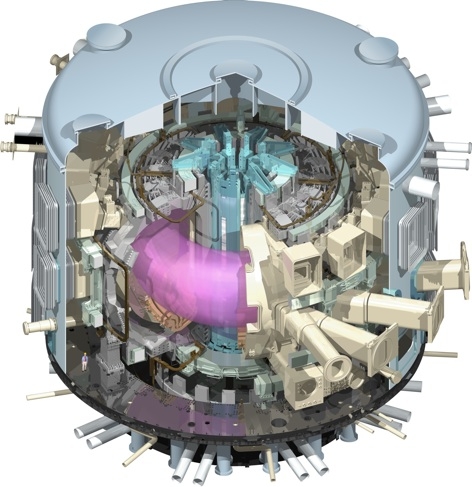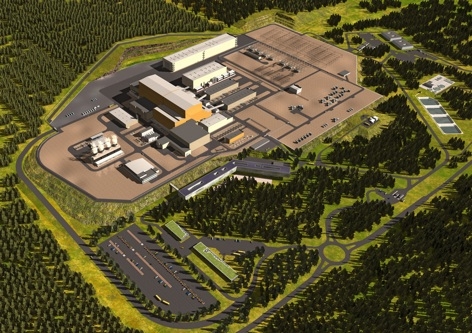Two of Europe’s mega-science projects have been in the news this week, although you could be forgiven for only noticing one of them. The latest findings from the Large Hadron Collider were widely reported, if poorly understood by pretty much everybody except the other CERN researchers and Prof Jim Al-Khalili — we might have glimpsed some Higgs Bosons, but we’ll have to wait until next year to be sure. Or more sure. Or something.
The other story didn’t make as many headlines. The ITER project, which aims to build the world’s largest magnetic confinement nuclear fusion experiment, succeeded in securing €1.3bn in extra funding for 2012 and 2013, which should keep the project on course to complete the building phase by 2018.
ITER and the LHC tend to be lumped togther as archetypal Big Science, particle physics experiments; for the cynics, of whom there are many, they are big holes into which money is poured to keep egg-heads happy. You’d expect us to be less cynical than that, and you’d be right; unsurprisingly we’re big fans of both projects here, but if you had to push us, ITER grabs our imagination a bit more.

There are several reasons for that. Firstly, ITER is — at the moment at least — very much an engineering project. Concrete has been poured at the site in Cadarache, in the South of France, and a massive plinth of foundations has taken shape. Components are under construction around the world, including parts for what will be the world’s largest superconducting magnets (taking the crown from the ones that currently bend the clouds of obscure fundamental particles into detectors at ATLAS, the LHC’s biggest experiment). And work is underway to characterise the type of materials that will protect the interior of the doughnut-shaped reactor vessel itself.
The other reason is that, fascinating and inspiring as the LHC might be, the significance of its results is obscure. There can be no doubt that expanding humanity’s understanding of the universe, how it was formed and the rules that govern its existance are noble and worthwhile goals (and I’d still rather my tax money was spent on that sort of thing than many of the policies the government sees fit to fund), but it’s still a struggle to see the significance. For me, at least, the real significance of the LHC is that it proves that thousands of people from dozens of countries speaking a dizzying array of languages can all work together on a common goal without coming to blows.
By contrast, ITER’s goals are very clear, and part of a continuum — is it possible to use magnetic confinement technology to ceate a self-sustaining nuclear fusion reaction that can be harnessed to produce usable, non-polluting, and economic energy? That’s an engineering goal — the application of pure science to one of society’s most pressing problems. In fact, when discussing the project with some of the lead researchers, they were adamant that ITER is entirely engineering. Magnetic fusion works, they told me; we know it works because we’ve proved it, operated it, and learned a lot from it. ITER is a scale-up operation; not an easy one, to be certain, and one with lots of unknowns, but it’s still a matter of developing technologies we’ve already investigated.

Nevertheless, ITER is still a physics experiment; that’s to say, it isn’t a power station. There’s a desire to connect a small heat exchanger and turbine to part of the reactor, just to prove that the heat produced can be used to generate electricity, but the point of the project is to create and sustain large-scale fusion. If this works, the next stage of the project is to build another fusion reactor, called DEMO, which would be optimised for industrial application and fully linked up to generating machinery. And all this brings the cost into focus.
There’s some thinking among opponents of the scheme that it’s just too expensive, that it can’t possibly justify the huge sums that it’s demanding, and that the growing budget is proof of that. Its full cost is currently estimated at €15bn (£13bn) — how can it possibly be worth that, they ask, especially at a time when Europe’s economies show every sign of teetering on the brink of recesssion or crumbling altogether?
But that ignores a few important facts. Firstly, ITER isn’t solely a European project; it also involves, and gets funding from, the US, China, Russia, India, Japan and South Korea (although the €1.3bn is a block solely from EU sources). Secondly, as the director-general of research and innovation at the European Commission, Robert Jan Smits, said, the goal of fusion ‘is so crucial for Europe and the whole world that we simply had to bite the bullet and try to find an agreement.’
And anyway, let’s put that funding into context, shall we? €1.3bn over two years from 27 countries? Sounds like a lot of money. Unless you have a look at the profits that oil companies make. In October, BP posted a first-quarter operating profit of €3.97bn. Look at that, and ITER starts to look like very good value indeed.










Water Sector Talent Exodus Could Cripple The Sector
Well let´s do a little experiment. My last (10.4.25) half-yearly water/waste water bill from Severn Trent was £98.29. How much does not-for-profit Dŵr...